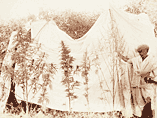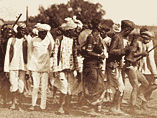 About the collection
About the collection
Drugs
The drugs reports in the Medical History of British India collection reveal the 19th-century controversies over indigenous drugs used for cultural and religious purposes and man-made medicines used to improve surgery.
Indian Hemp Drugs Commission report 1893-1894
From London to India
The Indian Hemp Drugs Commission report 1893-1894 is a thorough India-wide investigation of cannabis. In 1893 concerns were voiced in the House of Commons over hemp drugs in Bengal. A seven-member commission framed 70 questions throughout India to cultivators, military personnel, doctors, missionaries, traders, growers and many more, resulting in eight volumes of witness statements. The National Library of Scotland's report is thought to be the only copy in which striking photographs of Indian mendicants are preserved.
The Indian Hemp Drugs Commission report shows the relationship between cannabis users and the government, while exploring late 19th century perceptions and debates about the drug. The commission's clear objectives were to gather information about hemp cultivation, to determine the drugs prepared from it (such as bhang, charas, hashish, and ganja) and to identify its consumers. Questions on tax revenue and on the physical, mental and moral effects of hemp drugs were asked because the Commission was cautiously considering the consequences of prohibition.
Controversial conclusions
Indigenous to South Asia, cannabis was used for thousands of years for its nutritional, therapeutic, and intoxicating properties which led to it being embedded in Indian culture and religion. This, plus the loss of income from taxation if it were prohibited, led the commission to quickly deem that moderate use was not harmful. From experiments with monkeys, D D Cunningham showed that regular, immoderate smoking was beneficial to manual labourers on poor diets as the drugs slowed the rate of tissue damage.
Two Indian Commission members objected to the conclusions, stating that the drugs caused more injury, particularly to mental health, than was supposed in the report. Lunatic asylum statistics in the 1890s demonstrated that hemp drugs caused insanity, but the commission questioned their validity and found errors by Overseers.
The commission decided to control and restrict cannabis with adequate taxation, licensed cultivation and limits on sales and legal possession. Bengal, the origin of concerns about hemp drugs, was to become a model of this system for the whole of British India.
Second Report of the Hyderabad Chloroform Commission
Early anaesthetic agents
In 1799 Humfrey Davy was the first to have glimpsed the potential of nitrous oxide gas to make surgical procedures tolerable when it relieved his toothache. Yet it wasn't until 1846 when William Morton in Boston and James Robinson in England used sulfuric ether that interest in surgical analgesics grew beyond using alcohol and opiates. In the November of the following year James Young Simpson of Edinburgh discovered the potent effects of chloroform as an anaesthetic agent and promptly incorporated it into his obstetric practice.
Chloroform – discovered in 1831 – was more potent and was easier to use than ether, but it had severe side effects and religious protests about anaesthetics increased. The debates over its safety and comparisons to ether began in the medical community after the first fatality in 1848.
Edward Lawrie
In India, the Hyderabad Chloroform Commission was formed in 1888, headed by Surgeon-Major Edward Lawrie and funded by the Nizam to substantiate Lawrie's clean record using chloroform. Lawrie experimented on pariah dogs and concluded that death under the agent was due to respiratory failure. 'The Lancet' disputed his findings, resulting in the Nizam giving money for further work and the publication of the 'Second Report of the Hyderabad Chloroform Commission' in 1891.
Over 400 animal experiments – on monkeys, goats, horses, dogs, rabbits – and 52 human surgical trials were conducted and, like the first report, the results were inconclusive. Despite ending with 14 practical recommendations, it was met with doubt. Regardless of the documentation which meant that people could replicate his findings, Lawrie was criticised. He was particularly condemned over his heavy use of animals, which could not be compared to humans.
Doctors Gaskell and Shore studied the 1891 report and, armed with results of their own canine experiments, claimed that chloroform, unlike ether, caused cardiac arrest. Furthermore, they discovered that Lawrie's own findings did not back the Commission's conclusions. The Hyderabad Chloroform Commission was accused of incompetence in 1897, and Lawrie engaged in protracted feuds until his death from typhoid in 1915. The commission's report in the Medical History of British India collection illustrates the disputes and opinions about anaesthesia at the end of the 19th century.
Surgery revolutionised
As early as 1900 the BMA stated that chloroform was highly dangerous and 12 years later it was not recommended for use. Nitrous oxide gas, more efficient administration and monitoring, plus the discovery of agents in the 1930s of barbiturates such as hexobarbital, led to safer anaesthesia.
This, together with Lister's antisepsis regime and in the context of new models of the body, changed the character of 20th-century surgery.





